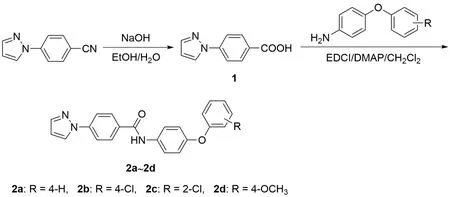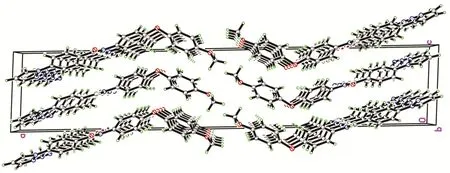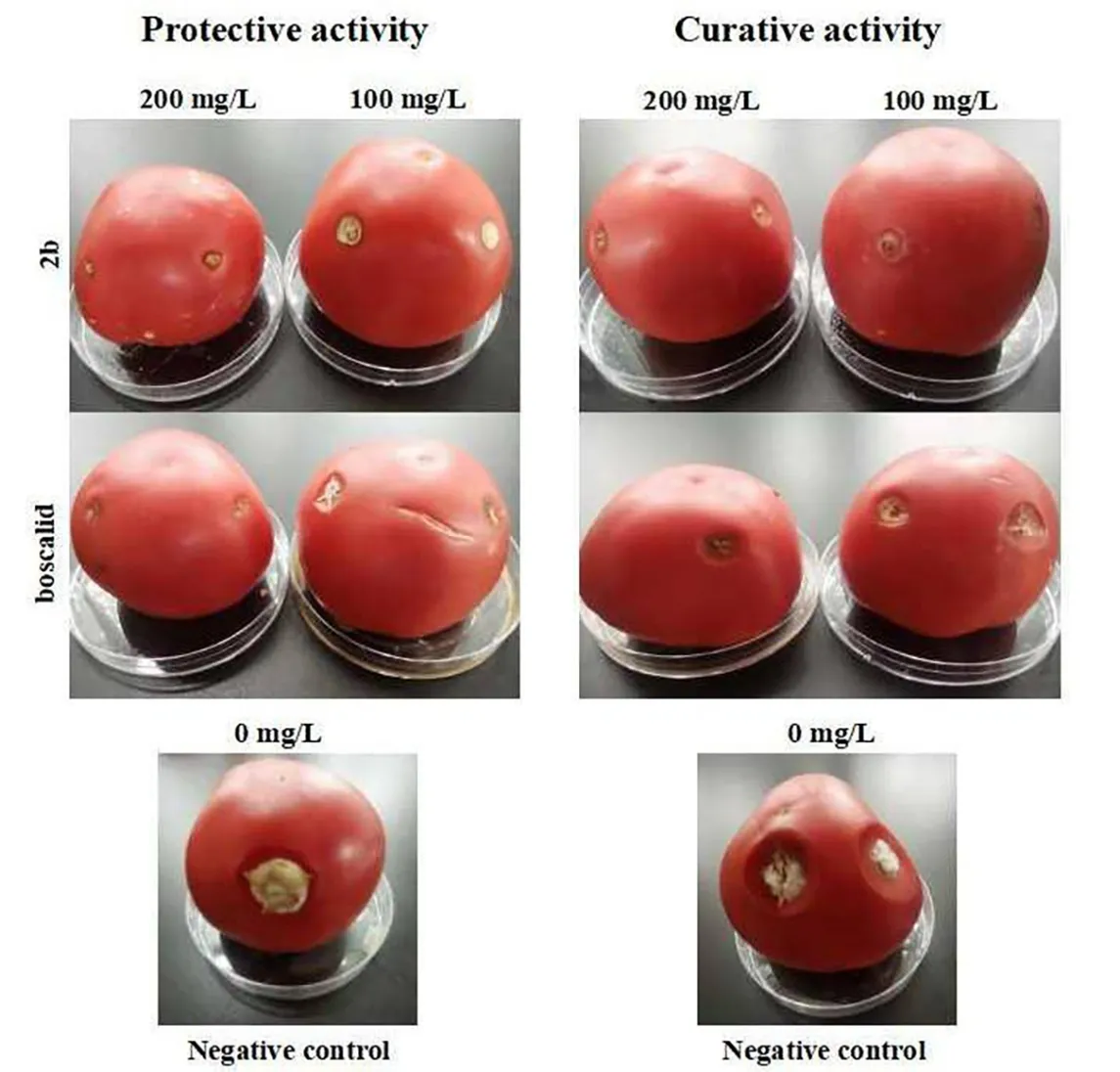Synthesis, Crystal Structure and Anti-fungal/Anti-oomycete Activity of New Pyrazole-benzene Carboxamide Derivatives①
YANG Zi-Hui LIU Qing-Song SUN Yue SUN Xue-Bao GU Wen
(Jiangsu Co-Innovation Center of Efficient Processing and Utilization of Forest Resources,College of Chemical Engineering, Nanjing Forestry University, Nanjing 210037, China)
ABSTRACT Four novel pyrazole-benzene carboxamide derivatives 2a~2d were synthesized and characterized by NMR, HRMS spectral method and X-ray diffraction analysis, and were further conducted for screening the anti-fungal/anti-oomycete activity. Compound 2d crystallizes as monoclinic space group P21/c with a =42.260(4), b = 5.3751(4), c = 8.0129(9) Å, β = 92.958(10)°, V = 1817.7(3) Å3, Z = 4, Mr = 385.41, Dc = 1.408 Mg/m3, S = 1.087, µ = 0.773 mm-1, F(000) = 808, the final R = 0.0763 and wR = 0.2136 for 2657 observed reflections (I > 2σ(I)). The preliminary antifungal assay indicates that the title compounds show fair to excellent antifungal/anti-oomycete activity toward four plant fungi and two crop oomycetes. Among them, compound 2b exhibits the strongest in vitro anti-B. cinerea effects (EC50 = 1.61 mg/L). In vivo test presents compound 2b displays considerable protective and curative effects to tomato fruits infected by B. cinerea. These results indicate that compound 2b would be potential fungicides leads for further development.
Keywords: pyrazole-benzene carboxamide, crystal structure, antifungal activity, anti-oomycete activity;
1 INTRODUCTION
Epidemic crops and trees diseases could strongly reduce the crop production and enormous losses each year. Researches revealed that more than 19,000 types of fungi and oomycetes caused nearly 200 plant diseases, which accounted for nearly 10% reduction of the major crops[1,2].This phenomenon had become a severe issue drawing increasing concerns all over the world. In addition, pathogenic oomycetes are virulent and hemibiotrophic pathogens which often cause great damage on some important vegetables[3].For example,Phytophthora infestans(P. infestans) andPhytophthora capsici(P. capsici) can cause destructive effects on the productivity of potato and pepper, respectively[4-6]. In addition, forest fungi have led to huge losses in the forest production, such as pecan and torreya. In the past decades,the application of fungicides was still an effective way to control these pathogenic fungi and oomycetes[7,8]. However,the widespread use and misuse of fungicides have caused rapidly increasing resistance in these pathogens[9]. Therefore,it is very urgent to develop novel, effective and environment friendly fungicides to control plant pathogenic fungi and oomycetes.
The application of heterocyclic group as active substructure was an important approach for fungicide design. Especially, nitrogen containing heterocycles are the key pharmacophores in many bioactive molecules[10,11]. Among them,pyrazole is an important five-membered heterocycle[12]and has been used in many synthetic agrochemicals owing to its diverse activities such as insecticidal[13], antifungal[14-17]and nematocidal activities[18-21]. A number of pyrazole derivatives were commercialized as fungicides with broad antifungal spectrum, including sedaxane, bixafen, isopyrazam and so on[22]. Moreover, the carboxamide moiety represents an important pharmacophore presented in many commercial pesticides, which displayed notable antibacterial, antifungal,herbicidal and insecticidal activities[23-27].
Based on these findings, novel pyrazole-benzene carboxamide derivatives 2a~2d were synthesizedviatwo steps and their structures were confirmed by NMR, HRMS spectra and X-ray diffraction. Thein vitroanti-fungal/anti-oomycete activities toward two forest fungi, two crop fungi and two crop oomycetes were studied, and thein vivoantifungal bioassay of compound 2b was conducted as well.
2 EXPERIMENTAL
2. 1 Materials and methods
Melting points were measured by an OptiMelt melting point apparatus (USA) and uncorrected. NMR spectra of the title compounds were gathered through a Bruker AV-600 spectrometer (MA, USA). The crystal structure of compound 2d was measured on an Agilent Super Nova Dual Atlas CCD diffractometer (USA). HRMS data were collectedviaa Waters G2-xs instrument (USA). The reagents and chemicals(AR) were bought from Juyou Chemical Co., Ltd. (China).
2. 2 Synthesis procedure of intermediate 1
A mixture of 4-(1H-pyrazol-1-yl)benzonitrile (0.338 g, 2.0 mmol), NaOH (0.160 g, 4.0 mmol) and EtOH/H2O (25 mL,v/v = 1:1) was refluxed in 105 °C for 16 hours. Then water(30 mL) was added to the product, which was extracted with EtOAc (30 mL). The water phase was acidified by HCl (6.0 mol/L) to pH = 5. The precipitate formed was filtered and dried to give compound 1. White solid, yield 65%, m.p.269~271 ℃.1H NMR (600 MHz, DMSO-d6)δ13.13 (s,1H), 8.65 (d,J= 2.3 Hz, 1H), 8.10 (d,J= 8.5 Hz, 2H), 8.02(d,J= 8.6 Hz, 2H), 7.85 (s, 1H), 6.63 (s, 1H).13C NMR(150 MHz, DMSO-d6)δ166.71, 142.73, 141.88, 130.94,128.24, 128.15, 117.92, 108.63.
2. 3 Synthesis procedure of the title compounds 2a~2d
4-Phenoxyaniline (1.0 mmol), EDCI (1.2 mmol) and DMAP (0.2 mmol) were added separately into the solution of compound 1 (1.2 mmol) in dichloromethane (10 mL). The mixture was then stirred at 25 °C for 2~5 h. After completion,the organic phase was filtered. The solid formed was washed with petroleum ether and desiccated to afford compounds 2a~2d.
Compound 2a: white solid, yield 70%, m.p. 179~181 ℃.1H NMR (600 MHz, DMSO-d6):δ10.33 (d,J= 6.9 Hz, 1H),8.65 (d,J= 2.5 Hz, 1H), 8.11 (d,J= 7.0 Hz, 2H), 8.02 (d,J= 8.8 Hz, 2H), 7.84~7.80 (m, 3H), 7.39 (d,J= 8.5, 7.4 Hz,2H), 7.12 (t,J= 7.8 Hz, 1H), 7.05 (d,J= 8.9 Hz, 2H), 7.00(d,J= 7.7 Hz, 2H), 6.61 (dd,J= 2.3, 1.9 Hz, 1H).13C NMR(150 MHz, DMSO-d6):δ165.15, 164.44, 157.31, 152.15,141.71, 132.03, 130.00, 129.29, 128.19, 123.06, 122.20,119.25, 118.31, 117.97, 117.71, 108.50. ESI-HRMS:m/zcalcd. for C22H18N3O2[M+H]+356.1399; found 356.1393.
Compound 2b: white solid, yield 73%, m.p. 243~245 ℃.1H NMR (600 MHz, DMSO-d6):δ10.83 (s, 1H), 7.98 (dd,J1= 7.8 Hz,J2= 1.5 Hz, 2H), 7.84 (d,J= 9.0 Hz, 2H),7.60~7.55 (m, 4H), 7.50 (s, 1H), 7.44~7.41 (m, 2H),7.10~7.08 (m, 2H), 7.03~7.02 (m, 2H).13C NMR (150 MHz,DMSO-d6):δ164.46, 156.33, 151.69, 141.80, 141.69,135.40, 132.00, 129.80, 129.28, 128.16, 126.72, 122.19,119.54, 119.47, 117.71, 108.47. ESI-HRMS:m/zcalcd. for C22H17ClN3O2[M+H]+390.1009; found 390.1013.
Compound 2c: white solid, yield 89%, m.p. 189~190 ℃.1H NMR (600 MHz, DMSO-d6):δ10.32 (s, 1H), 8.65 (d,J=2.5 Hz, 1H), 8.10 (d,J= 8.8 Hz, 2H), 8.02 (d,J= 8.8 Hz,2H), 7.82 (d,J= 1.5 Hz, 1H), 7.80 (m, 2H), 7.60 (dd,J= 8.0,1.5 Hz, 1H), 7.36 (td,J= 8.2, 1.6 Hz, 1H), 7.20 (td,J= 7.8,1.2 Hz, 1H), 7.06 (dd,J= 8.2, 1.4 Hz, 1H), 7.00 (m, 2H),6.61 (t,J= 2.3 Hz, 1H).13C NMR (150 MHz, DMSO-d6):δ164.65, 161.01, 154.87, 152.12, 141.69, 130.70, 129.21,128.77, 128.14, 125.02, 122.16, 122.05, 120.34, 118.10,117.70, 108.46. ESI-HRMS:m/zcalcd. for C22H17ClN3O2[M+H]+390.1009; found 390.1011.
Compound 2d: white solid, yield 80%, m.p. 213~215 ℃.1H NMR (600 MHz, DMSO-d6):δ10.27 (s, 1H), 8.65 (d,J=2.5 Hz, 1H), 8.10 (d,J= 8.7 Hz, 2H), 8.01 (d,J= 8.7 Hz,2H), 7.82 (d,J= 1.6 Hz, 1H), 7.75 (d,J= 9.0 Hz, 2H),7.00~6.95 (m, 6H), 6.61 (t,J= 2.1 Hz, 1H), 3.75 (s, 3H).13C NMR (150 MHz, DMSO-d6):δ165.01, 164.79, 155.87,154.20, 150.53, 142.23, 142.17, 134.66, 129.68, 128.63,122.60, 120.62, 118.28, 118.17, 115.52, 108.95, 55.89. ESIHRMS:m/zcalcd. for C23H20N3O3[M+H]+386.1505; found 386.1512.
2. 4 Crystal structure determination
Suitable crystal of compound 2d was cultured from CH2Cl2at RT. A colorless prism of 2d (0.14mm × 0.12mm ×0.1mm) was measured on a fiberglas at a random orientation.The data were gathered on a Dual Atlas CCD diffractometer with graphite-monochromated CuKαradiation (λ= 1.54184 Å) through anωscan mode within the range of 3.141≤θ≤66.591° (-49≤h≤50, -5≤k≤6, -5≤l≤9) at 169.99(10) K.Totally 5791 reflections were gathered, in which 3169 were independent (Rint= 0.0534) and 2657 were observed withI>2σ(I). The structure was solved by SHELXT-2018/2 and refined through full-matrix least-squares procedure onF2with SHELXL-2018/3[28]. All non-hydrogen atoms were refined anisotropically using the observed reflections withI> 2σ(I). All H atoms were generated geometrically and refined in terms of the riding model. The final refinement gotR= 0.0763,wR= 0.2136 (w= 1/[σ2(Fo2) + (0.1185P)2+1.4089P], whereP= (Fo2+ 2Fc2)/3),S= 1.087, (Δ/σ)max=0.001, (Δρ)max= 0.371 and (Δρ)min= −0.371 e/Å3.
2. 5 In vitro anti-fungal/anti-oomycete activity of compounds 2a~2d
The antifungal bioassay was screened at 50 mg/L according to the previous report[29,30]. Forest fungi,Botryosphaeria dothidea(B. dothidea);Fusarium solani(F. solani); crop fungi,Botrytis cinerea(B. cinerea),Gibberella zeae(G.zeae); crop oomycete:Phytophthora infestans(P. infestans)andPhytophthora capsici(P. capsici) were obtained from the Agricultural Culture Collection of China (ACCC).Fluopicolide and boscalid were used as positive control.
2. 6 In vivo bioassay on tomato fruits
Thein vivobioassay procedure of compound 2b was conducted according to the previous report[31]. Boscalid was co-assayed as positive control.
3 RESULTS AND DISCUSSION
3. 1 Synthesis
As illustrated in Scheme 1, compounds 2a~2d were prepared by treating the key intermediate (1) with corresponding 4-phenoxyanilineviaamidation reaction with high yields ranging in 70~90%. NMR and HRMS spectra were utilized to confirm the structures. For instance, the molecular formula of compound 2d could be determined as C23H19N3O3through its HR-MS spectrum (m/zcalcd. for C23H20N3O3:386.1505 [M+H]+; found: 386.1512). In the1H-NMR data of 2d, the appearance of singlet atδ10.27 ppm belongs to the proton of the amide group (N(3)). Two doublets atδ8.65 and 7.82 ppm and a triplet atδ6.61 ppm can be attributed to three heterocyclic protons in the pyrazole ring at C(10), C(8)and C(9), respectively. Two doublets atδ8.10 and 8.01 ppm can also be attributed to four aromatic protons of benzene ring at C(2)/C(6) and C(3)/C(5), respectively. The doublet at 7.75 ppm (2H) and six protons at 7.00~6.95 ppm are assigned to eight aromatic protons in the 4-phenoxyphenyl moiety. In addition, the singlet atδ3.75 ppm belongs to three protons of the methoxyl group (C(23)). The13C-NMR spectrum of compound 2d exhibits 17 well resolved resonances corresponding to 23 carbon atoms. Among them, the absorption peak atδ55.89 ppm is due to the methylene carbon (C(23)), and three peaks atδ142.17, 128.63 and 108.95 ppm result from the carbons in the pyrazole ring (C(8),C(10), C(9)). Meanwhile, four peaks atδ142.23, 134.66,129.68(2C) and 115.52(2C) ppm are attributed to the six carbons at the benzene ring (C(1)~C(6)), while the peak atδ165.01 ppm is the signal of amide carboxyl carbon (C(7)). In brief, the signals appearing in the NMR spectra of compound 2d are in good accordance with its structure. Furthermore,the structures of compounds 2a~2c could also be characterized by their spectral data in a similar manner.

Scheme 1. Synthesis route of compounds 2a~2d
3. 2 Crystal structure description
The crystal molecular structure of compound 2d is illustrated in Fig. 1. The bond lengths and bond angles within the pyrazole and benzene rings agreed well with the normal values (Table 1). The dihedral angle between the pyrazole heterocycle and its adjacent benzene ring (C(1)~C(6)) is 14.22(18)°,indicating that the two rings are not completely coplanar and thus not well conjugated, which was possibly owning to the steric hindrance between the two rings. Accordingly, the bond length of N(1)-C(4) is 1.413(4) Å, similar to the value of typical N-C bond (1.471 Å). However, the bond distance of N(3)-C(7) is 1.361(4) Å, shorter than the isolated N-C bond(1.471 Å) but longer than N=C bond (1.273 Å), which is due to the p-πconjugation effect between N(3) and the carbonyl group. The torsion angles C(2)-C(1)-C(7)-N(3) and C(7)-N(3)-C(11)-C(12) are -27.2(4)° and -35.2(4)°, respectively,indicating that the amide plane is not coplanar with both of its adjacent benzene rings (C(1)~C(6) and C(11)~C(16)). Thus,the dihedral angle between these two phenyl rings is 60.41(7)°.In addition, owing to the existence of ether group (O(2)), the dihedral angle between the two phenyl rings (C(11)~C(16))and (C(17)~C(22)) is 76.91(7)°.
The molecular packing diagram of compound 2d is presented in Fig. 2. There are two orientations of molecules presented in the crystal structure. The molecules are connected by two types of hydrogen bonds (N(3)-H(3)···O(1) and C(10)-H(10)···N(2)) (Table 2), forming chains along thebaxis. In addition, the two orientations of molecules pack alternately along thecaxisviaVan de Waals interactions, forming a layer of molecules. Along theaaxis, different layers of compounds pack through a head-to-head and tail-to-tail manner to form a three-dimensional network.

Table 1. Selected Bond Lengths (Å) and Bond Angles (°)

Table 2. Hydrogen Bond Lengths (Å) and Bond Angles (°) of Compound 2d

Fig. 1. X-ray crystal structure of compound 2d

Fig. 2. Molecular packing of compound 2d
3. 3 In vitro anti-fungal/anti-oomycete activity
As presented in Table 3, compounds 2a~2d displayed different degree of antifungal activity against the tested fungi.The primary bioassay showed that 2a~2d exhibited mild activities against two oomycetesP. capsiciandP. infestans,and very low inhibitionagainst two fungal strainsG. zeaeandF. solani. On the contrary, these compounds showed notable inhibitions toB. cinereaandB. dothidea. Compound 2b displayed 67.1% inhibition againstB. cinerea, which was near the value of boscalid (75.3% inhibition). Meanwhile,compound 2c exhibited 51.6% inhibition rate against forest fungiB. dothidea, which was approached to fluopicolide(59.5% inhibition). Based on such results, compound 2b was selected to further evaluate its fungicidal potency againstB.cinerea(EC50= 1.61 mg/L), which was equivalent to that of boscalid (EC50= 1.41 mg/L) (Table 4).
As for compounds 2a~2d, most of them demonstrate fair to notable anti-fungal/anti-oomycete activities towardB.cinereaandB. dothidea, with inhibition rates ranging from 0 to 70%. In general, 2b and 2c with electron-withdrawing -Cl group on the diphenyl core presented better antifungal effects than 2a or 2d with -H or electron-donating -OCH3group, which demonstrate that the electron-withdrawing groups on the phenyl moiety, such as -Cl group, could be more beneficial to the anti-fungal/anti-oomycete activity of these derivatives than the electron-donating groups.

Table 3. In vitro Anti-fungal/anti-oomycete Results of 2a~2d at 50 mg/L

Table 4. EC50 of Compound 2b and Boscalid against B. Cinerea

Table 5. In vivo Antifungal Activity of Compounds 2b
3. 4 In vivo antifungal activity of compound 2b against B. cinerea
The results presented in Fig. 3 and Table 5 indicate that compound 2b displays considerable protective effects againstB. cinereaat two dosages. Especially, 2b exhibits potent protective effects (85.3%) at 200 mg/L, which is equipotent to boscalid (88.6%). Meanwhile, it also displays good curative effect (77.1% and 61.1%) towardB. cinereaat the dosages of 200 and 100 mg/L, respectively, which is better than that of boscalid (41.1% and 40.0%). These results indicate that the selected compound 2b shows good curative effects to tomato fruits infected byB. cinerea.

Fig. 3. In vivo antifungal activity of compounds 2b
4 CONCLUSION
In this study, four novel pyrazole-benzene carboxamide derivatives were synthesized, characterized and screened for their anti-fungal/anti-oomycete activity. A potential bioactive compound 2b is found with considerable antifungal activity againstB. cinerea.This work provides new insights into the novel fungicides investigation. The in-depth structural modification and antifungal mechanism studies will be carried out in the future.
- 结构化学的其它文章
- Two Polynuclear Fe Complexes with Boat-like Core:Syntheses, Structures and Magnetic Properties①
- A Robust Heterometallic Cd(II)/Ba(II)-Organic Framework with Exposed Amino Group and Active Sites Exhibiting Excellent CO2/CH4 and C2H2/CH4 Separation①
- Synthesis, Crystal Structure, Spectroscopy and Hirshfeld Analysis of 4,6-Diamino-2-cyclopropylaminopyrimidine-5-carbonitrile with Different Solvents: N,N-dimethylformamide, Methanol and Water①
- Syntheses, Crystal Structures and DNA-Binding Properties of Zn(II) and Mn(II) Complexes Based on Imidazole Derivatives and Carboxylic Acid
- CoMFA Study on Anti-proliferative Activity of Fluoroquinolone Amide Derivatives①
- Synthesis and Properties of Dinuclear Europium(III)Complex Containing 2-Benzoylbenzoic Acid①

